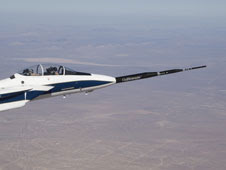
Sonic booms usually mean something cool. The space shuttle is coming in for a landing or a jet fighter is flying overhead. We don't hear them very often, so when we do it's an event.
But imagine if aircraft manufacturers designed and built a vehicle that carried passengers or cargo at supersonic speeds over land. Sonic booms would be happening all the time; and they're loud and annoying. That's why the Concorde flew over the ocean. Noise regulations in most countries wouldn't allow it to fly over land because of the sonic booms it generated.

Sonic booms are keeping a new era of supersonic cruise flight from happening.
For us to ever be able to enjoy the benefits of flying people or cargo over land at super-fast speeds, we have to figure out how to turn down the volume on sonic booms.
NASA has been doing flight tests and simulations and ground experiments -- with cool names like "Quiet Spike," "SonicBOBS," "SonicBREW," "LaNCETS," "House VIBES," "Low Boom/No Boom" – to help find answers.
What is a sonic boom? How is it created?
Do sonic booms cause damage? To people? Structures?
Does changing the noise level of a sonic boom affect aircraft speed?

On Tuesday, January 25, at 3:00 p.m. ET, you can ask NASA aerospace engineer and "sonic boom guru" Ed Haering about what it's like to try to tame a sonic boom.
To join the chat, simply come back to this page on January 25. The chat window will open at the bottom of this page starting at 2:30 p.m. ET. You can log in and be ready to ask questions at 3:00 p.m.
See you in chat!
More About Ed Haering

Ed is an aerospace engineer at NASA's Dryden Flight Research Center in Edwards, Ca. He really likes the variety of his work, which can involve starting up a new research program, doing computer simulations and analysis, troubleshooting instrumentation on exotic aircraft, and conducting field measurements in remote locations.

No comments:
Post a Comment